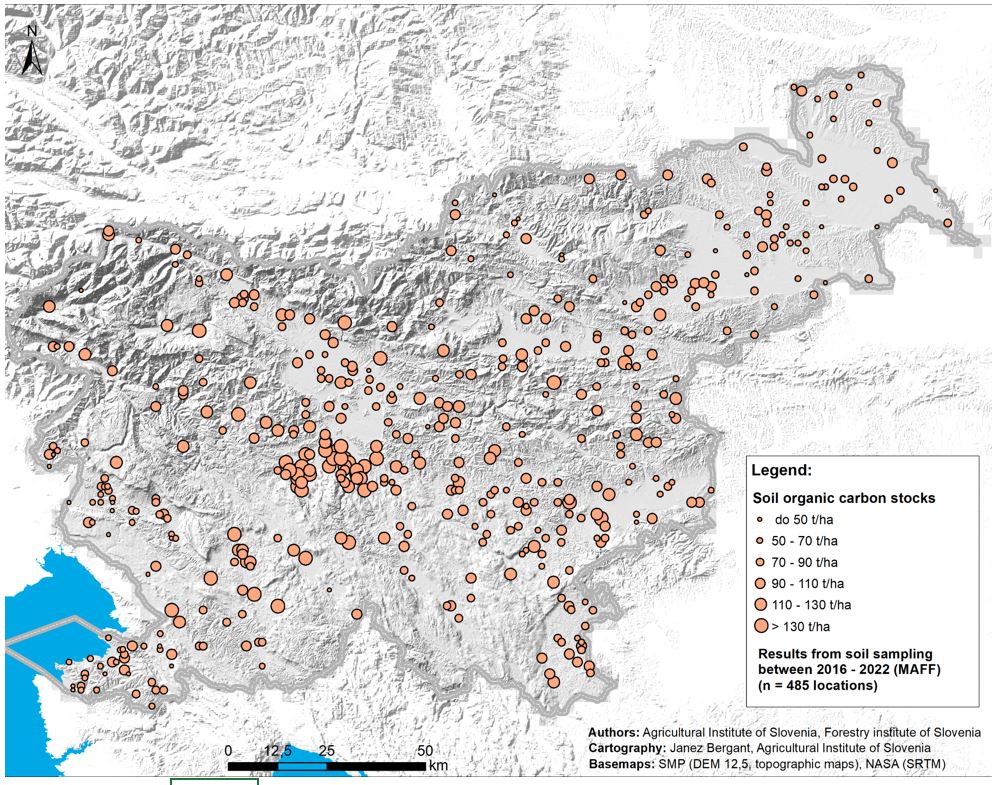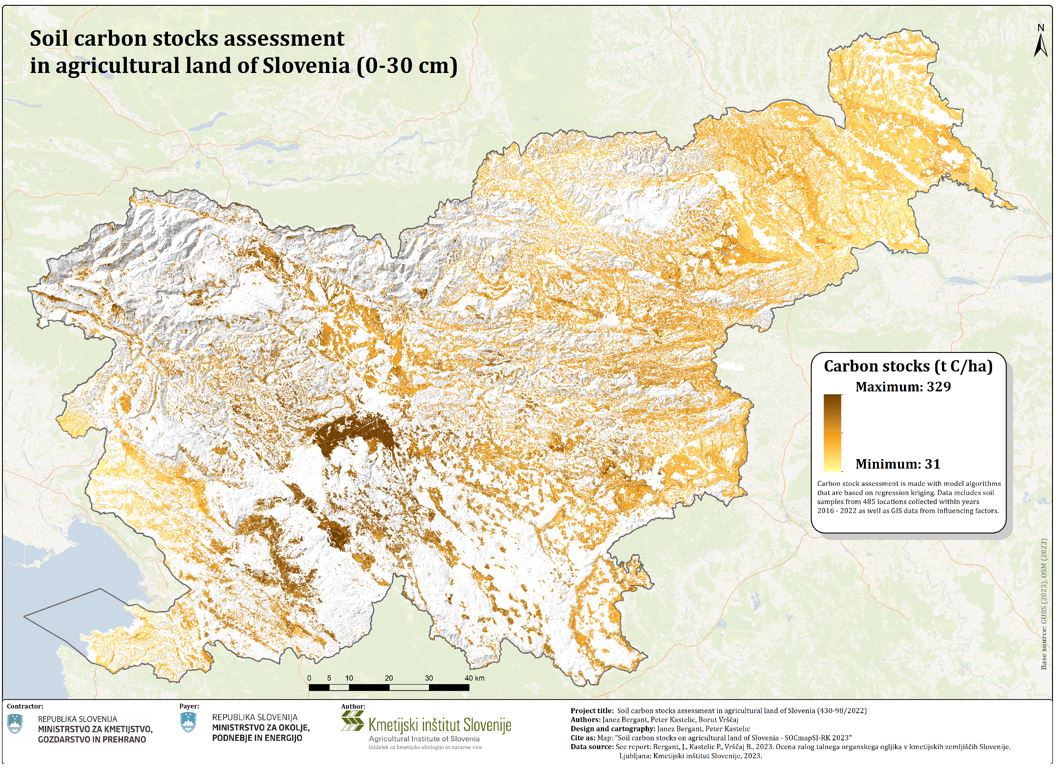[KM36] Soil organic carbon stocks

Key message

In Slovenia, the average Corg stocks in the treated agricultural lands (KZ) to a depth of 30 cm was 92.9 t/ha, with the highest in the soils of marsh meadows – 197.0 t/ha. In soils with extensive use, including extensive orchards (ES), permanent grasslands (TR), land undergoing afforestation (ZR), and KZ overgrown with trees and shrubs (DG), Corg stocks ranged from 92.2 to 109.4 t/ha. Corg stocks in vineyard soils (VI), intensive orchards (IS), and arable lands (NJ) ranged from 60.0 to 92.7 t/ha.
Conservation soil treatment and/or increased organic matter input into the soil leads to greater Corg accumulation in the soil and consequently reduces the amount of CO2 in the atmosphere, contributing to medium and long-term climate change mitigation.
The results of soil sampling and research in Slovenia confirm suitable or, compared to some other European countries, increased SOM content in agricultural lands. Nevertheless, it is still possible to increase SOM content in certain areas of Slovenia.
Definition
The indicator represents the stocks of soil organic carbon (Corg) or the content of soil organic matter (SOM) in agricultural land soils to a depth of 30 cm. The indicator displays:
- Average Corg content measured in soil samples at representative locations in the considered land uses of agricultural land.
- Average Corg stocks in soil (modeled values) in the considered land uses of agricultural land.
Both indicators consider selected agricultural land uses according to the RABA classification (MKGP 2022): arable land, vineyard, intensive orchard, extensive or grassland orchard, permanent grassland, marsh meadow, land undergoing afforestation, trees and shrubs.
Measured Corg content at representative locations and the estimation of Corg stocks in agricultural land are ultimate indicators of sustainable agricultural soil use, ensuring/maintaining fertility, and contribution of agriculture to the climate change mitigation
Charts
AIS, 2016-22; MAFF, 2016–22 (2023)
| Average organic carbon stock (measured values) [t/ha] | Estimation of total carbon stock (measured values) [Mt] | |
|---|---|---|
| Arable land | 92.70 | 15.96 |
| Vineyard | 60 | 0.93 |
| Intensive orchard | 71.70 | 0.31 |
| Extensive orchard | 92.20 | 2.18 |
| Permanent grassland | 98.40 | 30.87 |
| Marshmeadow | 197 | 1.08 |
| Agricultural land in overgrowth | 95.70 | 1.92 |
| Trees and shrubs | 109.40 | 3.20 |
AIS, MAFF (2022)
| Average organic carbon stock (modeled values)[t/ha] | Estimation of total carbon stock (modeled values)[Mt] | |
|---|---|---|
| Fields andallotments | 77.20 | 13.29 |
| Vineyard | 63.10 | 0.98 |
| Intensiveorchard | 68 | 0.29 |
| Extensiveorchard | 85.10 | 2.02 |
| Permanentgrassland | 92.50 | 29.02 |
| Marshgrassland | 216.30 | 1.18 |
| Agriculturalland inovergrowth | 89.90 | 1.81 |
| Trees andshrubs | 82.10 | 2.40 |
SMP, NASA (2023)
AIS (2023)
Goals
- Retaining and, where possible, increasing the content of soil organic matter (SOM) / organic carbon stocks in the upper soil horizons of all types of agricultural land use.
- Ensuring sustainable food production and supply with minimal soil water erosion.
- Enhancing soil ecosystem services directly related to SOM.
Comment
The content of soil organic matter (SOM) is the ultimate indicator of both agricultural and ecosystem soil quality. Soil fertility, crop yields and the success of agricultural production and husbandry are directly linked to the content of SOM. This important parameter is the carrier of the soil's ability to provide essential soil ecosystem services (SES) – services that soils perform in the environment. SES provide benefits to humans, animals, and other segments of the environment. Key environmental SES include soils as a carbon sink, thereby mitigating CO2 in the atmosphere; filtration, purification, and enrichment of water, thereby supplying groundwater with drinking water; retention and degradation of pollutants; retention, binding, release and cycling of macro and micro-nutrients; support for soil biodiversity and the abundance of soil biota.
Sustainable agricultural production and the contribution of agriculture to environmental protection and climate change mitigation are expressed through care for appropriate, and where possible, increased levels of SOM in the upper soil horizons.
The results of soil sampling and research in Slovenia confirm suitable or, in comparison to some other European countries, increased levels of SOM in agricultural lands. The average content of organic carbon in soils (Corg) in agricultural soils is highest in the upper soil horizons at depths of 0–10 cm (3–7%) and decreases with depth. At a depth of 20 to 30 cm, Corg content ranges from 2 to 3%. The highest Corg stocks in soils are in areas with trees and shrubs (DG), while the lowest are in vineyards (VI).
The average Corg stocks in the treated agricultural lands (KZ) to a depth of 30 cm was 92.9 t/ha, with the highest in the soils of marsh meadows – 197.0 t/ha. In soils with extensive use, including extensive orchards (ES), permanent grasslands (TR), land undergoing afforestation (ZR), and KZ overgrown with trees and shrubs (DG), Corg stocks ranged from 92.2 to 109.4 t/ha. Corg stocks in vineyard soils (VI), intensive orchards (IS), and arable lands (NJ) ranged from 60.0 to 92.7 t/ha.
Nevertheless, researchers believe it is still possible to increase SOM content in certain areas of Slovenia (e.g., Drava-Ptuj Field, Mura Plain, Vipava Valley) and certain land uses (e. g. vineyards, arable lands, intensive orchards).
Conventional treatment of KZ (e.g., intensive cultivation, deep plowing, and the use of only mineral fertilizers) increases greenhouse gas emissions from the soil (CO2).
Conservation (i.e., reduced, or minimal) soil treatment and/or increased organic matter input into the soil leads to greater Corg accumulation in the soil and consequently reduces the amount of CO2 in the atmosphere, contributing to medium and long-term climate change mitigation.
Efforts are being made to ensure that Common Agricultural Policy measures are directed toward promoting sustainable agricultural practices, better environmental protection, and a greater contribution of agriculture to climate change mitigation.
Methodology
- Batjes, N.H., 2014. Batjes, N. H. 1996. Total carbon and nitrogen in the soils of the world. European Journal of Soil Science , 47, 151-163. Reflections by N.H. Batjes. Eur J Soil Sci 65, 2–
- https://doi.org/10.1111/ejss.12115 (26. 10. 2022)
- Bergant, J., Kastelic, P., Vrščaj, B. 2023. Izdelava ocene zalog talnega organskega ogljika v kmetijskih zemljiščih Slovenije: končno poročilo. Ljubljana, Kmetijski inštitut Slovenije.
- Lefevre, C., 2017. Soil organic carbon: the hidden potential. Food and Agriculture Organization of the United Nations, Rome.
- Lorenz, K., Lal, R., 2018. Carbon Sequestration in Agricultural Ecosystems, 1st ed. 2018. ed. Springer International Publishing : Imprint: Springer, Cham.
- https://doi.org/10.1007/978-3-319-92318-5 (26. 10. 2022)
- Resolucija o Nacionalnem programu varstva okolja za obdobje 2020–2030 (ReNPVO20–30). http://www.pisrs.si/Pis.web/pregledPredpisa?id=ODLO1985
- Scharlemann, J.P., Tanner, E.V., Hiederer, R., Kapos, V., 2014. Global soil carbon: understanding and managing the largest terrestrial carbon pool. Carbon Management 5, 81–91.
- https://doi.org/10.4155/cmt.13.77 (26. 10. 2022)
- Smith, P., Soussana, J., Angers, D., Schipper, L., Chenu, C., Rasse, D.P., Batjes, N.H., Egmond, F., McNeill, S., Kuhnert, M., Arias‐Navarro, C., Olesen, J.E., Chirinda, N., Fornara, D., Wollenberg, E., Álvaro‐Fuentes, J., Sanz‐Cobena, A., Klumpp, K., 2020. How to measure, report and verify soil carbon change to realize the potential of soil carbon sequestration for atmospheric greenhouse gas removal. Global Change Biology 26, 219–241.
- https://doi.org/10.1111/gcb.14815 (26. 10. 2022)
- Soil organic carbon mapping cookbook, 2nd edition. ed, 2018. . Food and Agriculture Organization of the United Nations, Rome.
- Tifafi, M., Guenet, B., Hatté, C., 2018. Large Differences in Global and Regional Total Soil Carbon Stock Estimates Based on SoilGrids, HWSD, and NCSCD: Intercomparison and Evaluation Based on Field Data From USA, England, Wales, and France: Differences in total SOC stock estimates. Global Biogeochem. Cycles 32, 42–56.
- https://doi.org/10.1002/2017GB005678 (26. 10. 2022)










